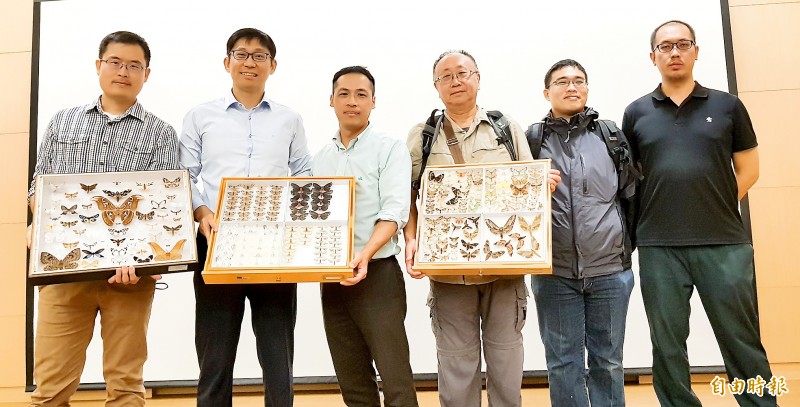《TAIPEI TIMES》 Academic Sinica researchers find link between moth coloration and habitat

Members of an Academia Sinica research team display moth specimens at a news conference in Taipei yesterday, including, from left, Shipher Wu, a postdoctoral researcher at the Biodiversity Research Center, Institute of Information Science research fellow Chen Sheng-wei and center associate research fellow Shen Sheng-feng. Photo: Chien Hui-ju, Taipei Times
By Lin Chia-nan / Staff reporter
Moths living at lower elevations and warmer environments develop richer colors, possibly because those with darker colors can retain more heat in cold regions, an Academic Sinica research team said yesterday.
The correlation between coloration and habitat elevations had been mostly a hypothesis, but the team used an artificial intelligence (AI) tool for image analysis to confirm the phenomenon with quantifiable and consistent data, Shipher Wu (吳士緯), a postdoctoral researcher at the Biodiversity Research Center, told a news conference in Taipei.
Taiwan has nearly 4,400 documented moth species — almost 10 times than the number of documented butterflies in the nation, but less than 10 researchers study moths in this nation, Wu said.
Thanks to an AI-assisted deep learning model, the Academic Sinica team was able to efficiently analyze more than 20,000 images of nearly 2,000 moth species, and found that environmental temperature is a factor affecting species coloration, he said.
The images were gathered by 103 professional and amateur observers who contributed to certain online moth databases from 2011 to 2016, including Council of Agriculture’s Endemic Species Research Institute Deputy Director Lin Hsu-hong (林旭宏), Wu said.
Whether moths with richer colors possess more advantages to help them survive needs further investigation, he added.
The team detailed their findings in a paper published in the journal Nature Communications on Oct. 7, “Artificial intelligence reveals environmental constraints on color diversity in insects,” with Wu as the lead author.
The deep learning model was developed by a group led by Chen Sheng-wei (陳昇瑋), a research fellow at Academia Sinica’s Institute of Information Science and director of the Taiwan AI Academy.
While he has seen AI widely applied in the medical and financial fields, this was the first time he used it, Chen said.
Unlike human eyes, which tend to simplify the traits of visual objects, deep learning can establish relations among a considerable number of images, he said.
Identifying species’ differences through human eyesight is subject to human bias and vision limitation, but AI technology can resolve these problems, said Shen Sheng-feng (沈聖峰), an associate research fellow at the center.
The team is working with Japanese researchers to gather more information of moths that live at higher latitudes, he said.
AI-assisted analysis is a new trend in biological studies, so Taiwan’s pool of information and technological talent gives the nation’s biologists an advantage, Shen said.
While some biologists might feel anxious about using AI in their research, they should consider it just another tool that can help them see better, he said.
Knowledge of biological traits could be used to design camouflage clothing and for other purposes as well, Shen added.
新聞來源:TAIPEI TIMES



















